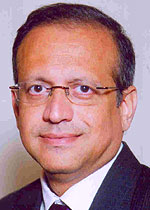Preparing for the next phase of growth
28 Feb 2007
The continued moderation of customs and excise duties will make Indian industry more competitive, says Milind Barve, managing director, HDFC Mutual Fund.
 The
union budget aims at striking a balance between sustained
economic growth, inflation and the social objectives
as laid down by the NCMP. There has been a renewed thrust
on agriculture, rural development programs, infrastructure
spending and employment generation programs. While the
budget has laid major stress on agriculture, education,
employment and health / welfare schemes, the implementation
of these projects will be critical in the achievement
of these objectives.
The
union budget aims at striking a balance between sustained
economic growth, inflation and the social objectives
as laid down by the NCMP. There has been a renewed thrust
on agriculture, rural development programs, infrastructure
spending and employment generation programs. While the
budget has laid major stress on agriculture, education,
employment and health / welfare schemes, the implementation
of these projects will be critical in the achievement
of these objectives.
The government is targeting a higher GDP growth rate of 8 per cent-10 per cent on a sustained basis and has recognised the need for a renewed thrust on infrastructure investments in order to achieve these objectives, and the proposed use of our foreign exchange reserves for this purpose is quite significant in that respect.
There is also the recognition that inorder to achieve the targeted growth rate, increased emphasis will have to be given to the agricultural sector and rural infrastructure as this sector employs over two thirds of the work force and contributes 20 per cent of GDP. The importance and role of the financial sector as an efficient delivery mechanism has been recognized, and efforts to create a more robust environment for their functioning is very progressive.
One of the positives of the budget has been the further moderation of customs and excise duties with an aim to make industry more competitive. The successful implementation of VAT and phased reduction of CST is a major positive as demonstrated by the robust collections. The scope of service tax has been expanded and is gaining importance as a major revenue generator.
On the direct taxation front, the 1 per cent additional cess on all taxes as well as the increase in DDT by companies and money market and liquid funds is a negative step and has no significant impact on revenues of the government.
The reduction of tax concessions is a necessity in order to create a level playing field, however we feel that the emphasis should be on increasing the tax base and compliance levels rather than frequent tinkering with taxation levels. With respect to the Mutual Fund industry we are pleased with the proposal to permit MFs to launch and operate dedicated infrastructure funds and with the proposal to permit individuals to invest in overseas securities through Indian mutual funds.
Overall,
the budget has maintained continuity of policy in key
areas, however its attempt to tackle higher inflation
seem rather hap hazard. On the positive side, it has
tried to adhere to revenue & fiscal deficit targets,
moderate tax structures and have attempted to provide
an enabling environment for achieving and maintaining
a higher growth rate.
Latest articles
Featured articles

The New Oil (Part 4): Can Technology Break the Dependency?
By Cygnus | 16 Jan 2026
Can magnet recycling and rare-earth-free motors reduce global dependence on strategic minerals? Part 4 explores breakthroughs, limits and timelines.

India’s Gig Economy Reset: The End of ‘10-Minute Delivery’ Hype?
By Cygnus | 14 Jan 2026
India’s quick-commerce sector is shifting away from “10-minute delivery” hype amid worker safety concerns and rising regulation. Here’s what changes—and what doesn’t.

AI Is Becoming the New Electricity Crisis: Why the Real Bottleneck Is Megawatts
By Axel Miller | 14 Jan 2026
AI is turning into an electricity crisis as data centres scale from chips to megawatts. Grid bottlenecks, copper demand and cooling limits are now the real AI constraints.

The New Oil: Can Technology End the Rare Earth Dependency?
By Cygnus | 14 Jan 2026
Magnet recycling and rare-earth-free motors are emerging as technology escape routes from critical mineral dependency. But timelines are slower than the hype suggests.

The New Oil: Inside the Processing Gap — Why Mining Alone Won’t Fix the Critical Minerals Crisis
By Cygnus | 13 Jan 2026
Mining isn’t the real bottleneck in critical minerals. The 2026 processing gap — refining, separation and chemical conversion — is the chokepoint reshaping global supply chains, industrial policy and geopolitics.

The Battle for the Skies: Air India’s Widebody Bet vs IndiGo’s XLR Gambit
By Cygnus | 12 Jan 2026
Air India vs IndiGo fleet strategy 2026: Air India expands with new Boeing 787-9 widebodies while IndiGo uses A321XLR efficiency and IndiGoStretch to reshape long-haul economics.

The Custom Dreamliner: Air India Reclaims Its Skies with First Post-Privatisation 787-9
By Axel Miller | 12 Jan 2026
Air India’s comeback under Tata enters a new phase as its first post-privatisation custom Dreamliner strengthens the fleet renewal push for premium long-haul travel.

The New Oil: How the 2026 lithium and graphite bottleneck could stall global EV growth
By Cygnus | 12 Jan 2026
Lithium and graphite are emerging as the key EV bottlenecks in 2026 as South America expands mining while China dominates processing and battery-grade conversion.

The New Oil: How the 2026 Rare Earth Shock Is Reshaping the Global Economy
By Cygnus | 09 Jan 2026
Japan launches a 6,000m deep-sea mission as China restricts rare earth exports. Discover how the 2026 “New Oil” crisis is redefining global high-tech trade.
Business History Videos

History of hovercraft Part 3...
By Kiron Kasbekar | Presenter: Kiron Kasbekar

History of hovercraft Part 2...
By Kiron Kasbekar | Presenter: Kiron Kasbekar

History of Hovercraft Part 1...
By Kiron Kasbekar | Presenter: Kiron Kasbekar









